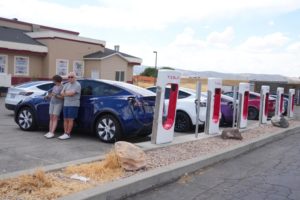
Pete Buttigieg (Photo by Keith Birmingham/MediaNews Group/Pasadena Star-News via Getty Images)
A former small-town mayor and 2020 presidential candidate has a vision. One day, all Americans will give up their gas-powered automobiles and embrace electric vehicles. The Pete Buttigieg EV dream has been touted on the airwaves, debate stages, and congressional hearings. This concept has been condensed to an edict that involves telling millions of motorists that the pain at the pump is a worthwhile financial torture method because it will encourage them to make that giant leap and spend $60,000 on a taxpayer-funded car to usher in a progressive wasteland. If life were only that simple.
Pete Buttigieg EV Dream in Washington
 Pete Buttigieg appeared before the July 19 House Transportation and Infrastructure Committee hearing, championing President Joe Biden’s proposal to subsidize the purchase price of electric vehicles and ensure that 50% of all automobiles sold by 2030 will be of the electric variety. The two-hour hearing had a few highlights, particularly two spats involving Buttigieg, Rep. Carlos Gimenez (R-FL) and Rep. Thomas Massie (R-KY).
Pete Buttigieg appeared before the July 19 House Transportation and Infrastructure Committee hearing, championing President Joe Biden’s proposal to subsidize the purchase price of electric vehicles and ensure that 50% of all automobiles sold by 2030 will be of the electric variety. The two-hour hearing had a few highlights, particularly two spats involving Buttigieg, Rep. Carlos Gimenez (R-FL) and Rep. Thomas Massie (R-KY).
The first exchange saw Buttigieg reiterate the position that higher gasoline prices are beneficial for the green agenda. “The more pain we are all experiencing from the high price of gas, the more benefit there is for those who can access electric vehicles,” he said, later adding that “we could have no pain at all by making EVs cheaper for everybody.”
The second altercation consisted of the libertarian-leaning Massie sharing figures regarding electricity consumption and EVs, which spotlighted the power grid’s significant challenges.
“Numbers are important. It would take four times as much electricity to charge the average household’s cars as the average household uses on air conditioning,” Massie stated. “So, if we reach the goal by 2030 that Biden has 50% adoption or 100% adoption, that means the average household would use twice as much electricity charging one of their cars as they would use for all of the air conditioning that they use for the entire year.”
Buttigieg responded by arguing that it is crucial that the nation update its infrastructure to ensure that the system can withstand millions of Americans adopting electric automobiles. “If we add yesterday’s grid with tomorrow’s cars, it’s not going to work,” Buttigieg averred.
“There’s needs and wants to make this fantasy work by 2030, but the reality is the capability is not going to be there,” explained the Kentucky representative, who revealed that he has installed solar technology in his home and believes in the long-term feasibility of renewable energy. Of course, Buttigieg has been on an EV marketing campaign crusade for the last several months, essentially howling to the moon that the solution to $5-a-gallon gasoline is to buy a $60,000 car.
The Reality of Buttigieg’s EV Utopia

Pete Buttigieg (Photo by Keith Birmingham/MediaNews Group/Pasadena Star-News via Getty Images)
In recent years, studies have exposed the plethora of problems with EVs. The first is certainly the cost. According to Edmunds, an online automotive information company, the average sale price is about $60,000, compared to the roughly $45,000 average for all new vehicles. When it comes to repairs, electric cars were as much as 2.3 times more expensive to service than gas-powered vehicles. Cold weather also eats into an EV’s range, as frigid temperatures can reduce a battery’s power by more than 40%. Even in hot temperatures, an EV’s distance is trimmed by 20% because of the air conditioner. Plus, statistics from the Energy Information Administration (EIA) show that the typical household could see as much as a 33% increase in its electric bill by charging an EV. Since electric cars typically need an entire evening to recharge at home, these vehicles will likely expand a residential property’s power consumption by more than 50%.
While this can cause troubles for the individual, widespread EV adoption can trigger nationwide issues.
The raging debate in politics, economics, and science circles is whether the national power grid can withstand an influx of EVs. Indeed, depending on the source and the media outlet, it is naively reported that today’s system can easily handle millions of additional EVs. However, other authoritative sources concede at the very least that the infrastructure will need major changes to handle the demand spike.
“Add electric vehicles on top of that, and you have a crisis of epic proportions in the making. The increased grid load from EVs not only would make power outages more likely but also the blackouts would be more harmful since large swaths of the population would be without transportation,” Liberty Nation’s Caroline Adana noted earlier this year.

(Photo by George Frey/Getty Images)
Moreover, EVs still depend on an electricity grid that relies on energy sources that the green lobby and climate alarmists will reject. EIA data from 2021 show that sources of US electricity generation are comprised of natural gas (40%), nuclear (20%), coal (19%), and renewables (20%). Therefore, charging a supposedly environmentally friendly vehicle will still require the use of fossil fuels.
Constructing an EV is also not great for the planet – or humanity. As Liberty Nation recently reported, manufacturing EVs would generally violate laughable ESG standards, mainly because batteries are made with forced labor (China) and the critical metals – copper, lithium, and nickel – are mined using environmentally harmful methods to the planet in developing markets (Congo).
EVs: What Are They Good For?
At this point, it is clear that there are more disadvantages to driving electric vehicles than there are advantages. Be it the exceptional strain on the power grid or taxpayer-funded boondoggles, the only utility that EVs serve is impressing latte-sipping urban dwellers who spend more time virtue signaling on social media than employing authentic tactics to limit their carbon footprint. Of course, this is the progressive way: demanding other people to change without leading the charge to alter society’s conventions.
Remember to check out the web’s best conservative news aggregator
Whatfinger.com — the #1 Alternative to the Drudge


